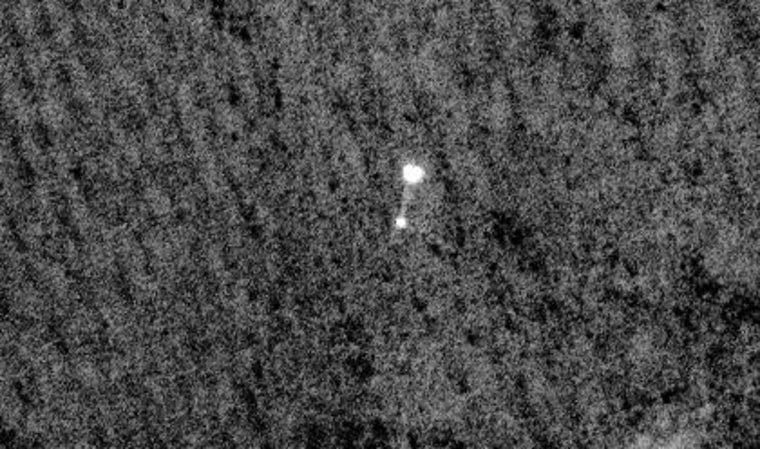NASA's Phoenix Mars Lander got down its first full day of work in the Red Planet's chilly north polar region on Monday, while the team behind the mission released an unprecedented picture showing the probe's descent as seen from above.
"Speaking as an engineer, this is equivalent to the first images of landing," NASA project manager Barry Goldstein told reporters. "This was quite an engineering feat."
The picture was taken on Sunday by NASA's Mars Reconnaissance Orbiter, which was passing overhead just as Phoenix was floating through Mars' thin atmosphere on the end of its parachute.
The 9-foot-wide (2.6-meter-wide) Phoenix spacecraft as well as its 30-foot-wide (10-meter-wide) parachute and cords were clearly visible, even though the orbiter was about 475 miles (760 kilometers) away. "There was an element of luck," MRO project manager Jim Erickson admitted.
Alfred McEwen of the University of Arizona’s Lunar and Planetary Laboratory said MRO's high-resolution camera has taken many amazing pictures of Mars, but "this one’s really unique."
"It’s the first time any camera has imaged an actual descent through an atmosphere of another planet," said McEwen, the principal investigator for the HiRISE camera. "This will be on my Top Ten list."
Follow-up imagery will be used to pinpoint the lander's precise location.
Goldstein said Phoenix landed near the edge of the target ellipse mapped out in advance by mission planners, because its parachute opened seven seconds later than expected. That appeared to be the biggest variation from NASA's delicately choreographed plan for the probe's descent and landing — a plan so fraught with potential problems that team members called it "seven minutes of terror."
The lander had to slow itself down from more than 12,000 mph (19,200 kilometers per hour) to a 5 mph (8 kph) touchdown using a combination of friction, parachute and thrusters.
Scientists and engineers at NASA's Jet Propulsion Laboratory in Pasadena cheered and sighed with relief late Sunday when they learned that Phoenix landed safely. Then they oohed and ahhed over the first pictures sent back from the polar region's weird, polygon-cracked terrain.
"'Seven minutes of terror' is going to be followed by three months of joy," Goldstein promised.
Martian permafrost
The images revealed a landscape similar to what can be found in Earth’s permafrost regions — geometric patterns in the soil likely related to the freezing and thawing of ground ice.
The Phoenix mission's principal investigator, Peter Smith of the University of Arizona at Tucson, said the landing site was "a scientist's dream."
During its 90-day primary mission, Phoenix will dig through layers of soil to reach the ice, believed to be buried inches to a foot (30 centimeters) deep. It will study whether the ice melted during a time in Mars’ recent past and will analyze soil samples for traces of organic compounds, which would be a possible indicator of conditions favorable for primitive life. Phoenix is not equipped to detect past or present alien life.
Over the next few days, Phoenix will snap more pictures of its surroundings to help scientists zero in on a digging site. “We’ve only looked at one tiny little slit” of the landing site so far, Smith noted.
Mission managers fully expect Phoenix to keep going after the first 90 days, although they say the probe will eventually fall prey to the Martian winter.
"We're going to operate until Mars freezes over," Goldstein said.
Checking out instruments
Phoenix landed on Mars after a 10-month, 422 million-mile (675 million-kilometer) journey. Over then next week, the probe will check out its science instruments and take more pictures of its polar surroundings, Smith said.
Phoenix joins the twin rovers on the Martian surface, which bounced down to the Martian surface cushioned by airbags in 2004 and have been exploring the equatorial plains ever since. Unlike the mobile rovers, Phoenix was designed to stay in one spot and dig trenches in the soil.
Goldstein said the lander appeared healthy, amid temperatures that were measured at 27 below zero Fahrenheit (-33 degrees Celsius). The first images confirmed that the lander unfurled its solar panels, hoisted its weather mast and started unwrapping the protective covering of its 8-foot-long (2.4-meter-long) robotic arm.
He said it appeared that the arm's protective cover around the arm did not unwrap all the way, but that should not affect the ability to unstow the arm.
Phoenix's touchdown marks the first successful rocket-powered soft landing on Mars since the twin Viking landers touched down in 1976. It avoided the fate of another polar explorer, the Mars Polar Lander, which crashed into the Martian south pole after prematurely shutting off its engines in 1999. Phoenix inherited the hardware of a lander that was canceled after the Polar Lander disaster, and carried instruments similar to those flown on the ill-fated 1999 mission.
The $420 million Phoenix mission is led by University of Arizona and managed by JPL.
This report includes information from The Associated Press and msnbc.com.
